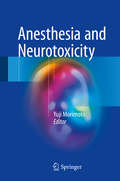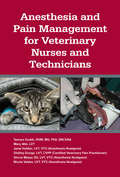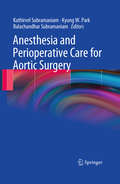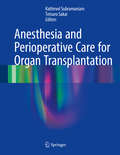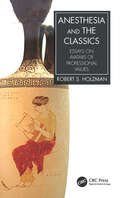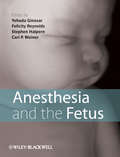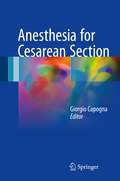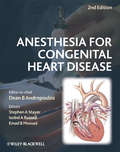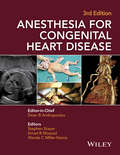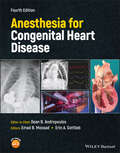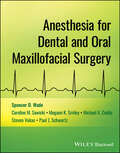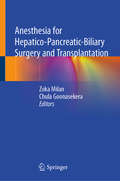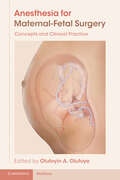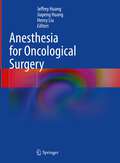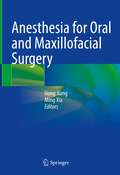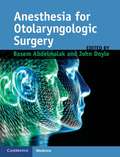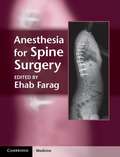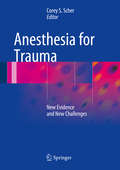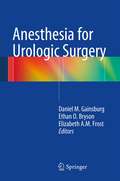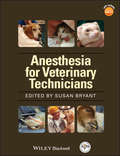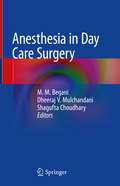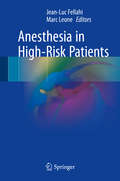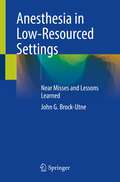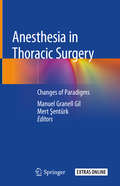- Table View
- List View
Anesthesia and Neurotoxicity
by Yuji MorimotoThis book, written by leading Japanese experts in the field, describes the latest findings on the neurotoxicity of anesthetics for the developing brain, postoperative delirium and cognitive dysfunction. It describes the risk factors for postoperative cognitive dysfunction in elderly surgical patients. Since the number of elderly patients undergoing surgery and anesthesia continues to increase, it is important to improve our understanding of the risks and mechanisms of postoperative delirium and cognitive dysfunction, potential ways to prevent or alleviate them and the public health implications. Recently, it has been shown that using anesthetics on the developing brain causes apoptotic neurodegeneration and persistent learning/memory deficits later in life. Anesthesiologists need more information on this mechanism in the human brain. The negative effects of anesthesia and surgery on the nervous system have attracted attention lately; this book provides physicians, researchers, and postdocs with invaluable information on this topic.
Anesthesia and Pain Management for Veterinary Nurses and Technicians
by Mary Albi Janel Holden Shelley Ensign Shona Meyer Nicole Valdez Tamara L. GrubbThis textbook and clinical guide is ideal for veterinary nurses and technicians in training. It offers a concise yet comprehensive resource for veterinary students and practitioners desiring a review of anesthesia and analgesia with step-by-step guidelines. A wealth of illustrations illustrate the theory in practice.
Anesthesia and Perioperative Care for Aortic Surgery
by Balachundhar Subramaniam Kathirvel Subramaniam Kyung W. ParkThis book is the first of its kind - a comprehensive reference for anesthesia and perioperative clinicians involved in aortic surgery. With a primary focus on anesthesia for various aortic surgical procedures, including endovascular aortic surgery, the title also provides expanded coverage of CNS monitoring and protection, intraoperative transesophageal echocardiography, renal and spinal cord protection during surgery, management of aortic trauma, and postoperative care. Written by top cardiac anesthesiologists, surgeons, and intensivists, this indispensable reference provides everything you need to know about the burgeoning field of aortic surgery in one handy volume.
Anesthesia and Perioperative Care for Organ Transplantation
by Kathirvel Subramaniam Tetsuro SakaiThis comprehensive textbook, covering all aspects of the perioperative management of patients undergoing organ transplantation, serves as the standard reference for clinicians who care for transplant patients on a day-to-day basis as well as those who encounter organ transplantation only occasionally in their clinical practice. Anesthesia and Perioperative Care for Organ Transplantation covers transplantation of the heart, lung, liver, pancreas, and kidney, as well as multivisceral and composite tissue graft transplantations. For each kind of transplantation, the full spectrum of perioperative considerations is addressed: preoperative preparation, intraoperative anesthesia management, surgical techniques, and postoperative care. Each chapter contains evidence-based recommendations, relevant society guidelines, management algorithms, and institutional protocols as tables, flow diagrams, and figures. Photographs demonstrating surgical techniques, anesthesia procedures, and perfusion management are included. Anesthesia and Perioperative Care for Organ Transplantation is for anesthesiologists and critical care physicians; transplantation surgeons; nurse anesthetists; ICU nurses; and trainees.
Anesthesia and Perioperative Care of the High-Risk Patient
by Ian McConachie MB ChB FRCA FRCPCThe fully updated third edition of this popular handbook provides a concise summary of perioperative management of high-risk surgical patients. Written by an international group of senior clinicians, chapters retain the practical nature of previous editions, with concise text in a bulleted format offering rapid access to key facts and advice. Several new chapters cover topics including: anesthetic mortality; cardiopulmonary exercise testing; perioperative optimization; obstructive sleep apnea and obesity hypoventilation syndrome; smoking, alcohol and recreational drug abuse; intraoperative ventilatory management; the role of simulation in managing the high-risk patient; anesthesia, surgery and palliative care; anesthesia and cancer surgery; neurotrauma and other high-risk neuro cases; anesthesia for end-stage renal and liver disease; and transplant patients. Essential reading for trainee anesthesiologists managing seriously ill patients during surgery or studying for postgraduate examinations, this is also a valuable refresher for anesthesiologists and intensivists looking for an update on the latest evidence-based care.
Anesthesia and the Classics: Essays on avatars of professional values
by Robert S. HolzmanA collection of 25 thought provoking Essays which create a bridge between the Classical personification of values and link them to current training and education in Western Medicine. This readable and erudite text provides a framework for modern clinical values - with a particular emphasis on anesthesiology - set in the context of ageless dilemmas facing each generation of physicians. Medicine as a profession carries some specific obligations.The qualities of empathy, knowledge, generosity, respect, and scholarship provide a "family" of values that was personified by the Ancients in the family of Asklepios, and which form the basis of professional values today. Moreover, a substantial amount of professional growth should come from reflection based on the experience of caring for real patients – an appreciation of the human condition. Each essay within this beautifully crafted book illustrates the importance of expertise, skill, focus, mindfulness, and collaboration, all of which are integral to professionalism in medicine, and in particular to those working in the field of anesthesiology. Anesthesiologists, Certified Registered Nurse Anesthetists and Anesthesia Assistants will find much to enhance their professional understanding within this text. The principles, values and traits of professionalism are relevant to all medical specialties and these essays provide a lyrical understanding of the traits required for professional development.
Anesthesia and the Fetus
by Stephen H. Halpern Felicity Reynolds Carl Weiner Yehuda GinosarAnesthesia and the Fetus integrates into one volume the multidisciplinary components of:fetal developmentfetal pharmacologyassessments of fetal and neonatal outcomeanesthesia and analgesia during pregnancyanesthesia and analgesia during laborethics and lawWritten by an internationally renowned group of clinicians and scientists, Anesthesia and the Fetus provides a contemporary guide and reference to the role of anesthesia, and the anesthesiologist, in protecting the mother and her unborn child during pregnancy.
Anesthesia for Cesarean Section
by Giorgio CapognaThis book examines every aspect of anesthesia in patients undergoing cesarean section. Anesthetic and surgical techniques are clearly described, with detailed guidance on indications and contraindications and identification of potential complications. Practical information is provided on postoperative analgesia, postoperative course and nursing, the significance of cesarean section for breastfeeding, and the occurrence of long-term problems and chronic pain after cesarean section. Other topics to be addressed include the history and epidemiology of cesarean delivery, effects on the fetus and neonate, ethical issues, the humanization of childbirth, and maternal expectations and satisfaction. While many books are available on obstetric anesthesia, none is exclusively devoted to cesarean section although it is one of the most frequently performed surgeries. Anesthesia for Cesarean Section will be appreciated by all anesthesiologists and will be a useful source of information for obstetricians, gynecologists, midwives, nurses, medical students, and trainees.
Anesthesia for Congenital Heart Disease
by Dean B. Andropoulos Emad B. Mossad Stephen A. Stayer Isobel A. RussellThis timely revision reflects the rapid advances in surgery and anesthesia for congenital heart disease that have occurred in recent years, including neonatal cardiac surgery and anesthesia, treatment of single ventricle patients, new diagnostic modalities, and developments in the catheterization laboratory. New chapters address mechanical support of the circulation, embryology, and quality/outcomes management.
Anesthesia for Congenital Heart Disease
by Dean B. Andropoulos Emad B. Mossad Stephen A. Stayer Wanda C. Miller-HanceThe third edition of Anesthesia for Congenital Heart Disease, the recognized gold-standard reference in this field, offers a major update and expansion of the textbook to reflect the ongoing development of the practice of pediatric and congenital cardiac anesthesia and the burgeoning knowledge base in this exciting field. Includes two new chapters addressing key areas; anesthetic and sedative neurotoxicity in the patient with congenital heart disease, and anesthesia in the patient with pulmonary hypertension Now in full color, with over 200 illustrations and photographs Multiple-choice questions accompany each chapter covering the most crucial learning points to optimize the learning experience for readers at all levels
Anesthesia for Congenital Heart Disease
by Dean B. AndropoulosAnesthesia forCongenital Heart Disease An Extensive Reference Work Detailing the Procedures, Knowledge, and Approaches in Anesthesia for Congenital Heart Disease In this fourth edition of Anesthesia for Congenital Heart Disease, a distinguished group of expert authors in congenital heart disease (CHD) from all over the world provide a thorough, comprehensive, and fully updated overview of the specifics of congenital heart disease and the intricacies involved with administering anesthetic care to patients who suffer from the myriad of lesions encompassed by CHD. In the seven years since the third edition of Anesthesia for Congenital Heart Disease was published, an explosion of new procedures, approaches, and patients eligible for anesthetic care has occurred. The goal of Anesthesia for Congenital Heart Disease, Fourth Edition is to help readers understand all of the recent advancements and developments in the field while also imparting a foundation of essential historical knowledge. The book contains new chapters that reflect exciting new approaches in this rapidly changing field, and also includes: Updated information in the chapter Adult Congenital Heart Disease and Mechanical Support of the Circulation, reflecting the increasing prominence of these patients in CHD care New chapters on Informatics and Artificial Intelligence, Genetic Syndromes, Point of Care Ultrasound, and Cardiopulmonary Resuscitation in Congenital Heart Disease Thorough updates of all chapters with many new figures and tables, and hundreds of new recent references provide up to date information Anesthesia for Congenital Heart Disease, Fourth Edition serves as a thorough and in-depth reference work and is an essential resource for practitioners providing perioperative care to CHD patients.
Anesthesia for Dental and Oral Maxillofacial Surgery
by Spencer D. Wade Caroline M. Sawicki Megann K. Smiley Michael A. Cuddy Steven Vukas Paul J. SchwartzAnesthesia for Dental and Oral Maxillofacial Surgery A comprehensive reference to anesthesia for dental, oral, and maxillofacial surgery Anesthesia for Dental and Oral Maxillofacial Surgery offers a comprehensive yet practical approach to anesthesiology for dentist anesthesiologists, oral and maxillofacial surgeons, and anesthesia providers in a dental environment. Taking a concise bulleted approach for fast access to information, the book covers all topics relevant to providing perioperative anesthetic management for the head and neck region. Coverage ranges from equipment, anatomy, physiology, and pharmacology to anesthetizing patients with specific conditions and for specific procedures. Designed for ease of use, the book makes it easy to find information relevant to cases ranging from common to rare. Anesthesia for Dental and Oral Maxillofacial Surgery readers will also find: Images throughout to facilitate key points A bulleted approach for easy reference A practical, accessible style, making it easy to find information at point of care Detailed coverage of preoperative aspects, pharmacology, key equipment, and more Anesthesia for Dental and Oral Maxillofacial Surgery provides anesthesia providers with all the information they need to confidently manage any case.
Anesthesia for Hepatico-Pancreatic-Biliary Surgery and Transplantation
by Zoka Milan Chula GoonasekeraThis concise, accessible book covers anesthesia for hepatico-pancreatic-biliary (HPB) surgery and transplantation, based on randomized clinical trials, meta-analyses, case series, reports, and hands-on experience. The anatomy, physiology, pathophysiology and clinical consequences are discussed, and the close ties between HPB resection and transplant anesthesia are explored. The content reflects current real-world practice, as liver and pancreatic transplant surgeries have substantially improved in terms of blood-loss reduction, fast tracking and reduced risk. The book also addresses anesthetic aspects in connection with the recently introduced and rapidly expanding practice of laparoscopic surgery; with enhanced recovery; and with pancreatic surgery. Anesthesia for Hepatico-Pancreatic-Biliary Surgery and Transplantation is intended for aspiring HPB and transplant anesthetists, anesthesia trainees, and consultants with experience in HPB anesthesia who want to see whether or not they’re up to date on the current standards.
Anesthesia for Maternal-Fetal Surgery: Concepts and Clinical Practice
by Olutoyin A. OlutoyeWith advances in ultrasound, birth defects are increasingly detected during pregnancy and may be amenable to surgical correction before delivery, to improve outcomes. This essential book discusses the different birth defects that can be treated during pregnancy and the important anesthetic considerations for the mother and fetus undergoing these procedures. Experts in the fields of anesthesiology, maternal fetal medicine, surgery, and pediatrics have come together to develop the content of this book. Enhanced throughout with full color images and illustrations, the book covers important topics such as spina bifida, twin-twin transfusion syndrome, sacrococcygeal teratoma, and lung masses, as well as fetal cardiac intervention, intrauterine transfusion, ex utero intrapartum treatment, and multidisciplinary approaches to fetal surgery. An invaluable guide for pediatric and obstetric anesthesiologists, anesthesiology, obstetrics, and surgical trainees, nurse anesthetists, and maternal-fetal medicine specialists.
Anesthesia for Oncological Surgery
by Henry Liu Jeffrey Huang Jiapeng HuangThis book fills the need for a single comprehensive work on oncological anesthesia written by anesthesiologists. Divided into 14 distinct sections, this title includes the most up-to-date surgical oncologic procedures/treatments (new adjunctive treatments, new surgical techniques), perioperative care and anesthetic considerations and protocols. The highly experienced authors explain how the new treatments affect anesthesia implementations. Chapters are formatted to be “Comprehensive and Concise”, COMPREHENSIVE means the book will cover almost everything related to the anesthetic management of oncological surgical procedures and treatment, CONCISE means each chapter will be practical in format to include surgical highlights, positions, paralysis, anesthesia options, monitoring, durations, anesthesia key points, postoperative analgesia, and postoperative destinations”. An invaluable resource for anesthesiologists, certified registered nurse anesthetists (CRNA), certified Anesthesiologist assistants (CAA), anesthesia trainees (anesthesiology residents/fellows, students registered nurse anesthetists, student Anesthesiologist assistants), and oncological surgeons.
Anesthesia for Oral and Maxillofacial Surgery
by Hong Jiang Ming XiaThis book reviews and describes anesthetic management of patients during oral and maxillofacial surgery. It covers applied anatomy of oral and maxillofacial surgery, difficult airway management and anesthetic techniques. The anesthetic management for patients with oral and maxillofacial disorders such as head and neck infection, head and neck injuries, and head and neck malignancy is also discussed. It will be a concise, up-to-date reference for specialists in anesthesiology, as well as practitioners in oral and maxillofacial surgery. It aims to share up-to-date knowledge and practical techniques with those who work in the fields related to oral and maxillofacial surgery.
Anesthesia for Otolaryngologic Surgery
by John Doyle Basem AbdelmalakAnesthesia for Otolaryngologic Surgery offers a comprehensive synopsis of the anesthetic management options for otolaryngologic and bronchoscopic procedures. Authored by world authorities in the fields of anesthesiology and otolaryngology, both theoretical concepts and practical issues are addressed in detail, providing literature-based evidence wherever available and offering expert clinical opinion where rigorous scientific evidence is lacking. A full chapter is dedicated to every common surgical ENT procedure, as well as less common procedures such as face transplantation. Clinical chapters are enriched with case descriptions, making the text applicable to everyday practice. Chapters are also enhanced by numerous illustrations and recommended anesthetic management plans, as well as hints and tips that draw on the authors' extensive experience. Comprehensively reviewing the whole field, Anesthesia for Otolaryngologic Surgery is an invaluable resource for every clinician involved in the care of ENT surgical patients, including anesthesiologists, otolaryngologists and pulmonologists.
Anesthesia for Spine Surgery
by Ehab FaragThe increased complexity of spinal surgical procedures in recent years has required more sophisticated anesthetic management of patients undergoing these procedures. Spine surgery anesthesia is now recognized as a distinct sub-specialty, increasingly undertaken by general anesthesiologists as well as neuroanesthesiologists. Anesthesia for Spine Surgery describes the anesthetic management and surgical procedures at every vertebral level in both adult and pediatric patients. The most important related considerations are covered, including: * Postoperative pain management * One lung ventilation during anterior thoracic spine surgery * Intraoperative neuromonitoring * Fluid management Additional chapters review the radiological features of normal and abnormal spines, common complications of spine surgery and ASA closed claims relating to spine surgery anesthesia. Written by highly experienced neuroanesthesiologists and spine surgeons, Anesthesia for Spine Surgery is essential reading for trainee and practising anesthesiologists, neuroanesthesiologists and spine surgeons.
Anesthesia for Trauma: New Evidence and New Challenges
by Corey S. ScherTrauma is the leading cause of death among people under the age of 40 and it ranks third for all age groups. Still, relatively few clinicians specialize in trauma and training is often obtained through experience The number of trauma patients is expected to continue to grow as pre-hospital care continues to advance. As well, hospitals increasingly see trauma treatment, which requires no pre-approval, as a good source of revenue. Given these developments, the number of opportunities for specialists trained in trauma, including anesthesiologists and critical care physicians, will expand in the years ahead. This book addresses the need for an up-to-date, comprehensive and clinically focused volume for practitioners and trainees in trauma anesthesia and critical care. It is organized by organ system. The editor is an attending physician at a major urban hospital center recognized worldwide for its outstanding emergency medical services including trauma care and is recruiting leading trauma anesthesiologists to contribute. Anesthesiologists, pain medicine physicians, critical care physicians and trainees are the target audience.
Anesthesia for Urologic Surgery
by Ethan O. Bryson Elizabeth A. Frost Daniel M. GainsburgThis is a concise, up-to-date reference on anesthesia for urological surgery. Urological anesthesia is not recognized as a specialty, and a majority of anesthesiologists and nurse anesthetists will provide anesthesia for these patients. Advances in urological procedures, the advent of treatment of patients with strong anticoagulant and antiplatelet medications, and the demographics of urology patients (many of whom are young or elderly) present challenges for the anesthesiologist and have necessitated changes in anesthesia practice. The last volume on this topic was published in 2000, and the time is right for a fresh presentation of contemporary expertise in anesthesia for urological surgery. The book provides a brief review of renal physiology and pharmacology then addresses anesthesia for each major group of urological procedures (e.g., endoscopic, office-based, laparoscopic and robotic, nephrolithotripsy, renal transplantation, etc.) and in special populations, including the geriatric patient, the pediatric patient, and the pregnant patient. Separate chapters discuss the unique challenges of positioning the patient, and of managing the patient taking anticoagulant and antiplatelet medication, and the chapter on pain management addresses common and important perioperative concerns. The book provides a brief review of renal physiology and pharmacology then addresses anesthesia for each major group of urological procedures (e.g., endoscopic, office-based, laparoscopic and robotic, nephrolithotripsy, renal transplantation, etc.) and in special populations, including the geriatric patient, the pediatric patient, and the pregnant patient. Separate chapters discuss the unique challenges of positioning the patient, and of managing the patient taking anticoagulant and antiplatelet medication, and the chapter on pain management addresses common and important perioperative concerns.
Anesthesia for Veterinary Technicians
by Susan BryantAnesthesia for Veterinary Technicians is a highly practical guide to anesthesia skills for veterinary technicians published in association with the Academy of Veterinary Technician Anesthetists (AVTA). Packed with hints and tips to aid technicians in the practice of veterinary anesthesia, the book offers an essential resource to building anesthesia skills and improving knowledge. Encompassing both background knowledge and practical application of anesthesia-related skills, Anesthesia for Veterinary Technicians is a valuable resource for veterinary technicians of all skill levels.Supplementary website materials, including charts and forms for use in the practice, are available at www.wiley.com/go/bryant.
Anesthesia in Day Care Surgery
by M. M. Begani Dheeraj V. Mulchandani Shagufta ChoudharyThis book features a collection of guidelines for anesthesia in day care surgery, covering all medical specialties that may look to venture into the ambulatory surgery domain. It provides various practical tips that can be used in day-to-day practice by anesthetists and surgeons alike, and covers various anesthetic protocols used by the stalwarts of the industry to illustrate the ideal techniques for anesthesia in day care surgery.
Anesthesia in High-Risk Patients
by Marc Leone Jean-Luc FellahiThis book describes the approach to anesthetic and perioperative management in different categories of high-risk patient scheduled to undergo elective noncardiac surgery. Individual sections focus on patients with conditions entailing cardiac and hemodynamic risks, respiratory risks, renal and metabolic risks, neurological risks, and other forms of risk. For each condition, up-to-date guidance is provided on risk evaluation, risk stratification, and intraoperative and postoperative anesthetic management. This is the first time that such different clinical situations have been gathered together in a single textbook of anesthesiology. All of the authors are international experts with extensive clinical experience. The aim is to provide trainee anesthesiologists with clear guidance that will prove invaluable when managing a wide range of patients with serious illnesses or conditions that pose a significant anesthetic risk. The book will also serve as a valuable reference for more experienced anesthesiologists and intensivists.
Anesthesia in Low-Resourced Settings: Near Misses and Lessons Learned
by John G. Brock-UtneThis book outlines the many anesthesia-related obstacles, concerns, and challenges that may be encountered by western trained anesthesiologist in low-resourced settings. Each chapter presents a challenging scenario with solutions. It is therefore an essential handbook that will prepare those performing anesthesia in this milieu. All case studies represent real accounts discussing equipment and drug constraints as well as the ethical questions that arise for western doctors working in this environment.Socially conscious and timely, Anesthesia in Low-Resourced Settings is an invaluable resource for medical practitioners who plan to work in these challenging settings.
Anesthesia in Thoracic Surgery: Changes of Paradigms
by Mert Şentürk Manuel Granell GilThis book reviews and describes the best practices of anesthesia in thoracic surgery, according to evidence-based medicine. It covers preoperative assessment, applied pharmacology, airway management and ventilation methods. The analgesic methods in this surgical specialty are also discussed. This book is aimed at all specialists in the world of anesthesiology and critical care as well as to physicians in training. It may also be of interest to thoracic surgeons and pulmonologists.
